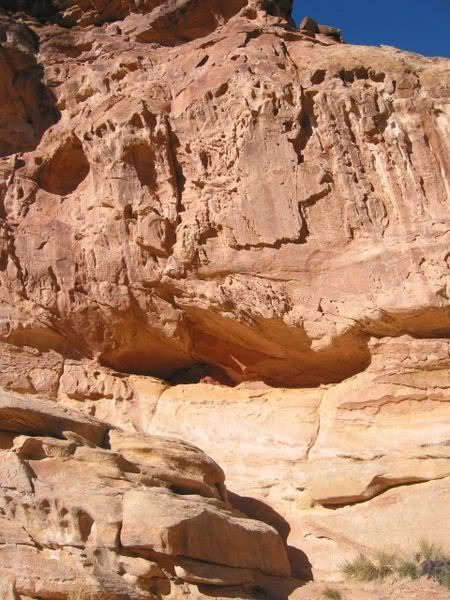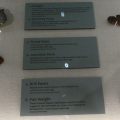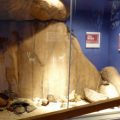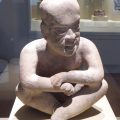( – promoted by navajo)
It is not uncommon for accounts of American history to begin in the fifteenth century with the Spanish voyages of exploration. What the Europeans found was not a wilderness, but a land which had been settled by and developed for American Indians. By two thousand years ago there were a number of highly developed agricultural American Indian civilizations in North America. In this diary, I’d like to briefly describe a few of the events which happened about two thousand years ago in the area which would later become the United States.
California:
Indian people in Kern, Fresno, and Tulare counties had started a pictographic style of rock art which the archaeologists call Southern Sierra Painted Style. The paintings are complex patterns which include humans and animals.
Florida:
The Calusa built a 2.5 mile canal across Pine Island. The canal was 18-23 feet wide and 3.5 feet deep so that it was large enough to handle most Calusa canoes. To control the water flow in the canal, the Calusa used a series of eight stepped impoundments which functioned like locks and a series of auxiliary channels which diverted excess flow.
Indian people along the Crystal River had begun construction of a series of shell mounds which have astronomical alignments. The mounds and stone pillars were used to observe the solstices and equinoxes.
Louisiana:
Indian people at the Marksville site have begun construction of earthworks on a bluff overlooking Old River Lake. They constructed a semicircular earthwork that is about 3-7 feet high and about 3,300 feet long. The earthwork marked off a ceremonial area. There were five conical mounds within the earthworks, the tallest of which was 20 feet in height and is 100 feet across at its base.
Maine:
Indian people on Deer Island were making pottery. The pottery tended to be thin, hard, and generally well made. This suggests that ceramic techniques or even the pots themselves were introduced as a developed complex from the people of the drainages to the southwest.
Arizona:
Indian people in what is now the downtown area of present-day Phoenix constructed a village with 38 pithouses and three surface features. They built both circular and rectangular pithouses. Some of the pithouses were small, circular structures about six feet in diameter. The rectangular houses were as large as 18 by 13 feet.
Kentucky:
A man was killed two miles inside Mammoth Cave when a six-and-a-half ton boulder fell on him. The man-later nicknamed Lost John-was about 45 years old; 5 feet 3 inches tall; and weighed about 145 pounds. Since Indian people had been mining in the cave, it has been speculated that Lost John was mining gypsum or other minerals such as epsomite or selenite when the boulder crushed him.
Tennessee:
Near Pinson, Tennessee Indian people built an array of earthen mounds which were linked in a design scheme that extended for many miles. The largest mound-Sauls Mound-was 87 feet high and had a 50 square foot flat top, all built with no machinery. The site appears to have been used only occasionally for ceremonial purposes by local groups. The site appears to have been built with a master plan which places Sauls Mound in the middle.
Gaul (actually in Europe):
The king of the Suevians presented the Roman proconsul, Quintus Metellus Celer, with a gift of Indians who had been cast up on the shores of Germany during a storm.
Hopewell:
Hopewell was a mound-building culture whose hearth appears to have been in present-day Ohio. By 2,000 years ago, the culture had expanded outside of this area.
In Kansas and Missouri, the Hopewell people developed an efficient adaptation to the riverine environment near the junction of the Kansas and Missouri Rivers. The Hopewell settlements included large villages – 5 to 10 acres in size – which were frequently situated at the bluff line where tributary streams flow into the river. In addition, they occupied smaller camps – .5 to 2 acres in size – on terraces within stream valleys. These smaller camps were seasonally occupied hunting and gathering camps.
With regard to economics, the Hopewell people in Kansas and Missouri were doing some farming to supplement hunting and gathering. The primary protein source was deer with some fish and turkey. Gathering included wild nut crops as well as some wild seed crops, such as amaranth.
Near the village, the Hopewell people built mounds which covered stone-vault tombs. Within the mounds were both primary and secondary burials as well as cremations.
In Georgia, the Mandeville site was established by Indian people who were participating in what archaeologists call the Hopewell Interaction Sphere. Artifacts at the site which were identified as Hopewell include copper panpipes, copper ear spools, mica, platform pipes, ceramic figurines, galena, and “Flint Ridge” blades.




Leave a Reply